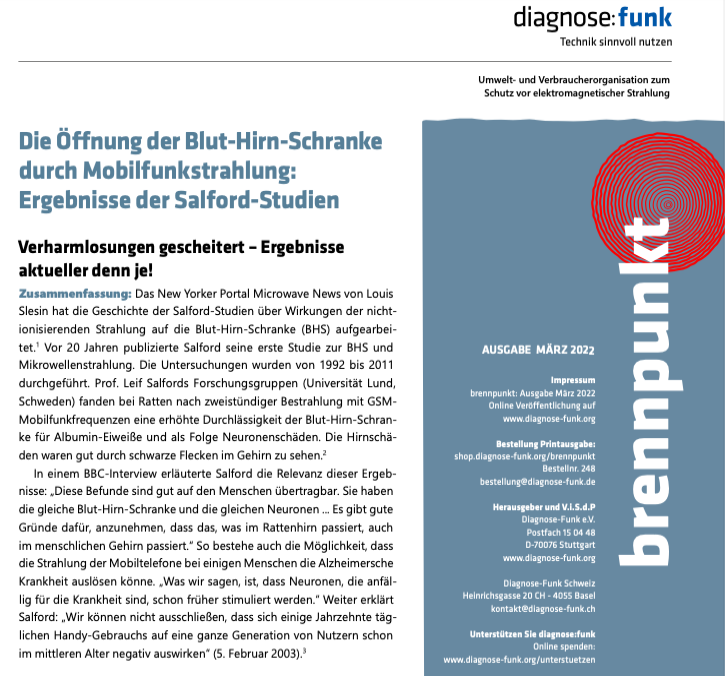Abandoning Inconvenient Science
How RF Research on the Blood-Brain Barrier
Was Shut Down — Again
Reflections on Leif Salford’s 80th Birthday
Leif Salford celebrated his 80th birthday on December 7. An emeritus professor at Sweden’s Lund University and a noted neurosurgeon, Salford spent much of his career treating patients with brain tumors. Over the years, he became frustrated as, all too often, he was unable to save them with a scalpel.
In 1987, Salford came across a paper in Neuroscience Letters from a group at the University of Western Ontario, who had found that rats undergoing the equivalent of a routine MRI scan showed changes in their blood-brain barrier. The BBB is a membrane that keeps potentially toxic substances in the bloodstream from getting into the brain. It’s not a perfect barrier —it can leak. The Canadians reported that something about the electromagnetic exposures during the MRI scan had increased the permeability of the rats’ BBB. It had become more porous.
If microwaves (RF) used in the MRI were responsible, Salford thought, perhaps he could open the BBB using focused radiation and deliver a therapeutic drug to kill tumors without surgery. So began Salford’s second career. Collaborating with Bertil Persson, a Lund professor of radiation physics, Salford worked on microwaves and the BBB for the next 20 years.
Salford and Persson’s own experiments with rats confirmed, at least to themselves, that microwave radiation —sometimes at very low levels— could alter BBB permeability. With the help of another Lund colleague, Arne Brun, a professor of neurosurgery, they went on to show that chemicals that had crossed into the brain could kill neurons.
The Lund scientists would come to call themselves the “Three BBB Musketeers.”
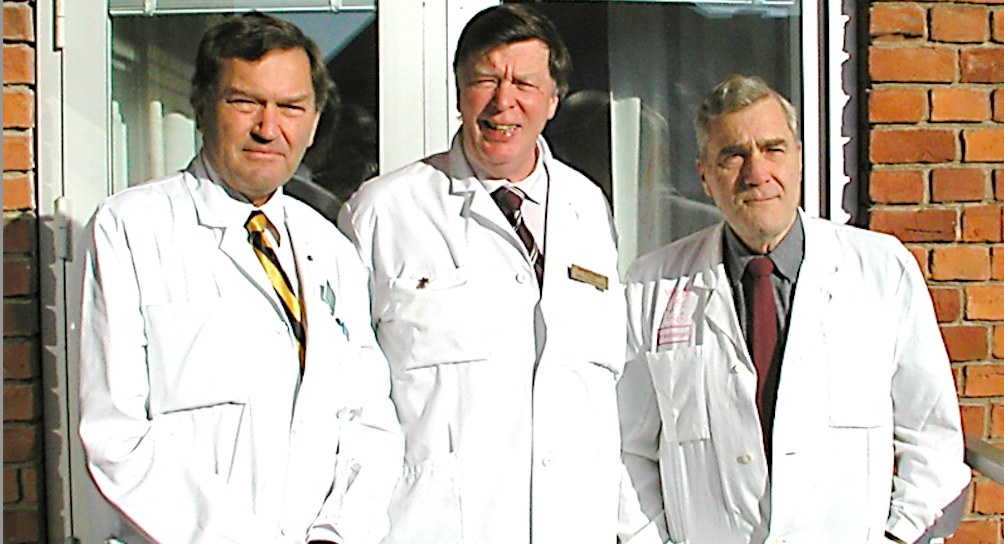 Leif Salford, Bertil Persson and Arne Brun (left to right) in 2003.
Leif Salford, Bertil Persson and Arne Brun (left to right) in 2003.
As the use of cell phones skyrocketed in the 1990s, what had started out as a possible new cancer treatment segued into a major health controversy. Billions of people were now holding a microwave transmitter next to their brain; some kept it there for a long time. What if the microwaves were damaging brain cells, leading to Alzheimer’s or other neurological diseases?
Salford and Persson traveled widely, presenting their findings at scientific workshops and conferences. They published papers in peer-reviewed journals. Everyone doing microwave health research became familiar with their work on the BBB.
Salford himself was hard to miss at meetings. Friendly and genial to the extreme —he is the perfect dinner companion— Salford speaks with a striking English accent.
At the end of the ’00s, Salford and Persson stepped back and without them, interest in microwaves and the BBB faded into the background. The turning point had come a few years earlier, at a 2003 workshop, held at Reisenburg Castle, about 30 km east of Ulm, Germany.
After Reisenburg, the BBB became a “dead duck,” Persson told me recently in an email exchange.
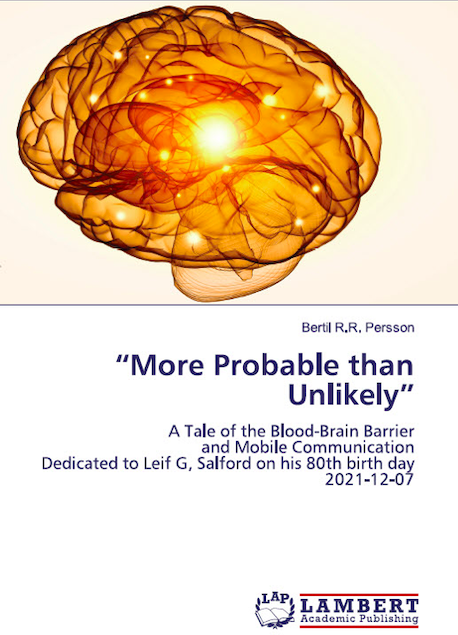
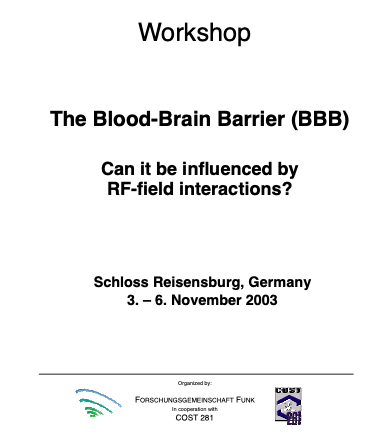
The Covers of Bertil Persson's Book and the Reisenburg BBB Program
Last month, on Salford’s birthday, Persson presented him with a short history of their BBB journey. He had written and published the slim volume for the occasion. The book includes not only their scientific work, but background on how some had tried to discredit it. The “hope,” Persson told me, was to bring the duck back to life.
The title of the book is from a talk Salford gave at a conference in Thessaloniki, Greece, in May 2008. “It is more probable than unlikely,” he said, “that non-thermal electromagnetic fields from mobile phones and base stations do have effects upon the human brain.”
This was a variation of a warning Salford had issued years earlier and which had become a meme for the latent fear of microwaves. The worldwide adoption of cell phones is “the world’s largest biological experiment ever,” he told the European Parliament in June 2000. (A copy of his ppt slides is here.)
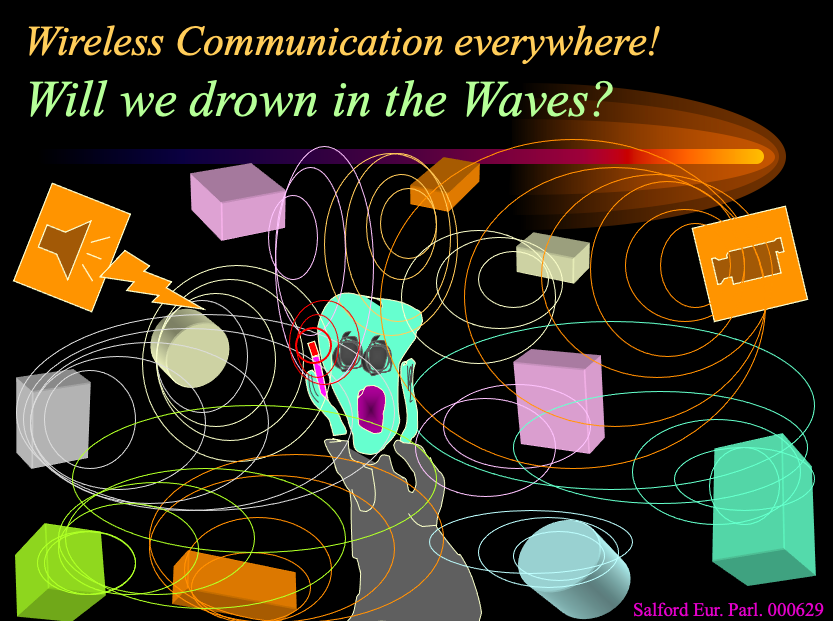 Leif Salford’s Final Slide in His Talk to the European Parliament on June 29, 2000.
Leif Salford’s Final Slide in His Talk to the European Parliament on June 29, 2000.
Tales from Reisenburg Castle
Much of the book is about what happened at the Reisenburg workshop. The meeting was run by the FGF —short for Forschungsgemeinschaft Funk— an arm of the German telecom industry, set up to oversee health research. Just about everyone interested in the effects of microwaves on the BBB was there, about 50 participants in all. Among them were Monika Asmuss of the German Office of Radiation Protection (BfS), the country’s chief sponsor of microwave health studies; Konstantin Hossmann, the director of the Max Planck Institute for Neurological Research in Cologne, who was doing microwave–BBB experiments for Motorola; Dariusz Leszczynski of STUK, the Finnish radiation protection authority; and Bernard Veyret, the head of the University of Bordeaux microwave research group. The U.S. Air Force sent a member of its Directed Energy Bioeffects Division at Brooks AFB in Texas. There was a large contingent from the FGF, as well as representatives from Nokia, T-Mobile and Vodafone. I had invited myself, and Gerd Friedrich, FGF’s managing director, agreed to let me come.
Salford and Persson had initially been ambivalent about going to the workshop. “They invited us here to shoot us,” Persson told me over dinner on our first evening in Reisenburg Castle. “There is so much politics, but we felt we had to come.”
Salford showed up a day late. He had been with the Queen of Sweden, he said from the podium before turning to the science. She’s interested in this, he added. “She sends her regards.” Salford went on to give his standard presentation, detailing how microwaves could open the BBB and allow molecules to cross into the brain where they could damage neurons. They had published these findings in Environmental Health Perspectives earlier in the year—a paper that attracted widespread attention. (Microwave News ran a cover story.)
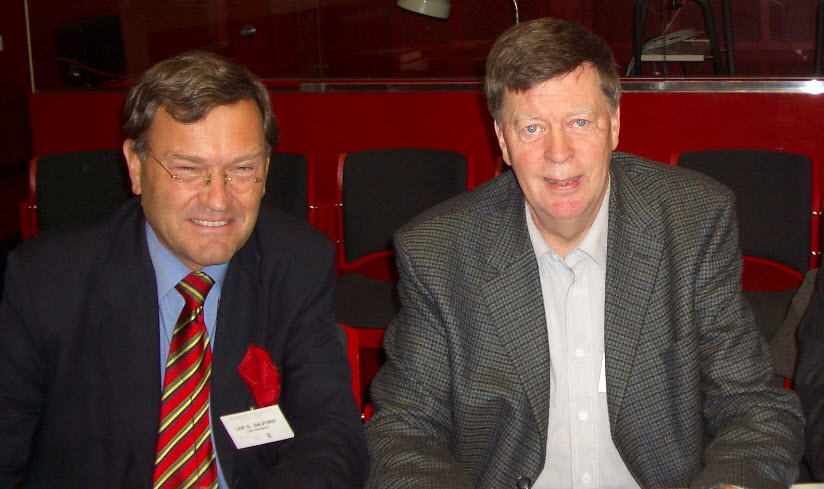
Leif Salford and Bertil Persson in Reisenburg.
Microwave Headaches
Pierre Aubineau, the director of research at the University of Bordeaux National Center for Scientific Research, had decided to come to Reisenburg at the last minute and was given a slot on the program. Two years earlier, he and his colleague Fatma Töre had shown that GSM radiation allowed proteins to leak from small blood vessels in the brain’s dura mater into the meninges. The proteins act as irritants, he had posited, and this may be the reason that cell phone users have been complaining about headaches. “The proteins cause inflammation and edema, which can bring on a headache,” he told me at the time (another cover story).
Two months before the workshop, Aubineau had submitted a manuscript¹ to The Lancet, in which he speculated that microwaves could cause “pathological events” among heavy users of mobile phones. But when we met during a coffee break at the workshop, he was more interested in telling me about his collaborator —or more correctly, his former collaborator— Bernard Veyret.
Aubineau filled in the backstory. Veyret had recruited him to join the microwave team. At his suggestion, Aubineau had applied for a government grant. “I was convinced that I would not find anything,” he said. “Then I would move on to other projects.” That’s not how it turned out.
Aubineau did see changes. He and Veyret prepared a manuscript for publication. But, out of the blue after months of editing, Veyret reversed course and asked that his name be removed from the paper. He had been a coauthor of two of Aubineau and Töre’s conference abstracts; now he wanted out. “Bernard could not accept the conclusion,” Aubineau told me in Reisenburg. “I was disgusted with his behavior. I’ll never work with him again.”
By 2003, Veyret was a leading member of the microwave establishment. Early in his career, Veyret had wanted to follow in the footsteps of another Bordeaux scientist, Antoine Prioré who claimed he could use electromagnetic radiation to cure cancer. That was in the past; now Veyret was an unyielding member of the only-thermal school. Three years earlier, he had been elected to the International Commission on Non-Ionizing Radiation Protection (ICNIRP).
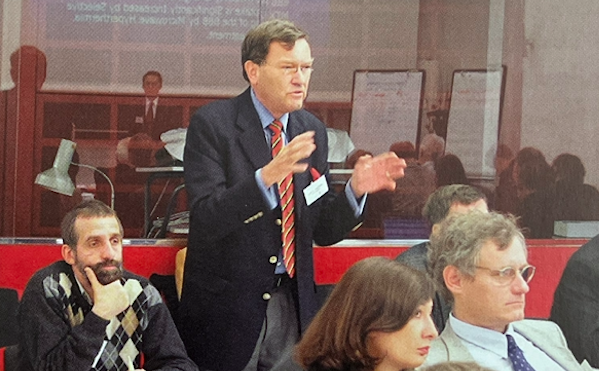 Leif Salford makes a point at the Reisenburg BBB Workshop; Veyret, wearing a blue tie, is on the right.
Leif Salford makes a point at the Reisenburg BBB Workshop; Veyret, wearing a blue tie, is on the right.
As would be expected of an ICNIRP acolyte, Veyret refused to acknowledge that Salford and Persson were reporting a non-thermal effect. At this point in his career, Veyret had never published a paper on the BBB.
Veyret understood that Aubineau was —albeit indirectly— confirming the Swedish work. Aubineau was also seeing leakage, albeit in other blood vessels. But that could be interpreted as proof of principle. At every turn in Reisenburg, Veyret cut off this line of argument.
STUK’s Leszczynski added more fuel to the Salford-Persson fire. He had identified molecular pathways that could explain how RF could lead to increased BBB permeability. Much of what Leszczynski presented in Reisenburg had been published in the journal Differentiation a year earlier. To emphasize that what he was seeing had nothing to do with heating, the title of Leszczynski’s paper began: “Non-Thermal Activation...”
The workshop organizers had invited David Begley of the Blood-Brain Barrier Group at King’s College London to serve as an informal rapporteur. “I come away from this meeting more convinced than ever that there is an RF effect,” he said during the closing session. Begley singled out Leszczynski’s findings as particularly persuasive. “Dariusz’s results were striking,” he said, “they show very, very clear biological effects.”
Still, Begley was not jumping to any conclusions. He wanted to know more. “We have these observations,” he said. “But how important are they? Are they significant or insignificant?”
Salford was in complete agreement: More work had to be done. “We have to find out,” he said. “I would be very, very happy if it turns out that [what we are seeing] makes no difference to the human brain.” But, he insisted, “We should find out if it is dangerous.” He was particularly concerned about children using mobile phones.
Leszczynski felt the same way. Any “final conclusions” are still premature, he said. He too urged more studies to clarify the issue.
Money Flows to Bordeaux
After Reisenburg, Leszczynski, Persson and Salford scaled back their research on the BBB. They had all run out of money.
As for Aubineau, he walked away and never looked back. “I’m tired of working in this field; it’s more politics than science,” Aubineau told me as he was leaving to go home. “I’m going to retire and go sailing in Turkey.” He appears to have done exactly that. Aubineau never published the paper he had submitted to The Lancet. He dropped out of sight and I never heard from him again.
There was one clear winner. After the workshop, Veyret’s Bordeaux lab was awash in BBB research money. Within a few months, Germany’s BfS awarded Isabelle Lagroye, a senior member of his research group, a three-year, €300,000 (~$350,000) grant to repeat the Salford-Persson work. France Telecom and Bouygues Telecom supported the lab to do similar experiments.
During this same period, two leading cell phone trade groups—the Mobile Manufacturers Forum (MMF) and the GSM Association— gave Veyret’s group money for other microwave health studies.
At the end of every project, the Bordeaux group reached the same basic conclusion: They saw no deleterious effects other than those caused by overheating. Their preferred journal was Radiation Research, which has a long history of publishing negative results on non-thermal effects. (John Moulder, a principal gatekeeper at Radiation Research, had a side gig as a consultant for the telecoms.)
“The findings of our study did not confirm the previous results of Salford et al.,” Lagroye and Veyret reported in a 2009 paper on the work they had done for the MMF and GSMA. Their final report for the BfS, filed two years earlier, reached the same conclusion: “The results of Salford et al. are not supported.”
Strangely, the Bordeaux group took ten years to publish the results of their BfS project. They finally appeared in Scientific Reports in 2017. There was very little, if anything, new in that paper that had not been in Lagroye’s 2007 BfS report. In the acknowledgements, they thanked Monika Asmuss, their BfS project manager. At the time, Asmuss was a member of ICNIRP.
Over the years, Asmuss had also overseen about a dozen BfS research grants to Alexander Lerchl, a German professor who has devoted much of his career to ridiculing microwave health effects and attacking those who disagreed.
U.S. Air Force Sees No Leakage
The USAF group² at Brooks AFB also ran BBB experiments. Patrick Mason, who was in charge, had touted a multi-center project. But when they published in 2009, the only authors were from Brooks. No one was surprised that they too saw no microwave-induced leakage. “Using a very similar experimental approach, we have been unable to confirm [the] results” of Salford and his colleagues, they wrote.
The USAF paper was also published in Radiation Research. It had cleared peer review with amazing speed —in less than six weeks. Both of the Bordeaux BBB papers had taken more than seven months to be accepted.
ICNIRP: “No Evidence of an Effect”
Eighteen months ago, in May 2020, ICNIRP issued updated guidelines for exposure to microwave radiation. It was the first revision in more than 20 years, and it includes a nine-page assessment of the health literature. ICNIRP exposure limits only address thermal hazards since the Commission has never acknowledged non-thermal effects. Only five lines of text are devoted to the BBB:
“There have also been reports of radiofrequency EMFs inducing leakage of albumin across the blood-brain barrier in rats, but due to methodological limitations of the studies and failed attempts to independently verify the results, there remains no evidence of an effect.”
There is one citation to the work of the Salford group, but none to any of the “failed attempts.”
Veyret stepped down from ICNIRP in 2012 after a 12-year run, the maximum allowed. Lagroye who was designated an ICNIRP scientific expert in 2009 is still active on the Commission. By far the largest sponsor of ICNIRP is the BfS.
It Has All Happened Before
Salford and Persson were not the first to show that microwaves could alter the permeability of the BBB. They were in the second wave.3 The first was led by Allan Frey —the same Allan Frey who has been in the news in recent stories on the Havana Syndrome. In that context, the “Frey Effect” refers to his discovery that it’s possible to “hear” pulsed microwaves.
Microwave-induced BBB leakage is the other Frey effect, first reported in the Annals of the New York Academy of Sciences in 1975. “It appears that RF electromagnetic energy affects brain permeability and behavior,” Frey wrote back then.
Frey’s motivation was much like Salford’s. “Part of my thinking was using [EMFs] to open the BBB to treat brain tumors with meds such as methotrexate,” he told me recently via email.
Work on the Frey BBB effect was quietly suppressed by the U.S. Air Force and U.S. Navy. Nicholas Steneck presents a full account of the cover-up in his 1984 book, The Microwave Debate.4 At the time, Steneck was a professor of history at the University of Michigan (he is now emeritus).
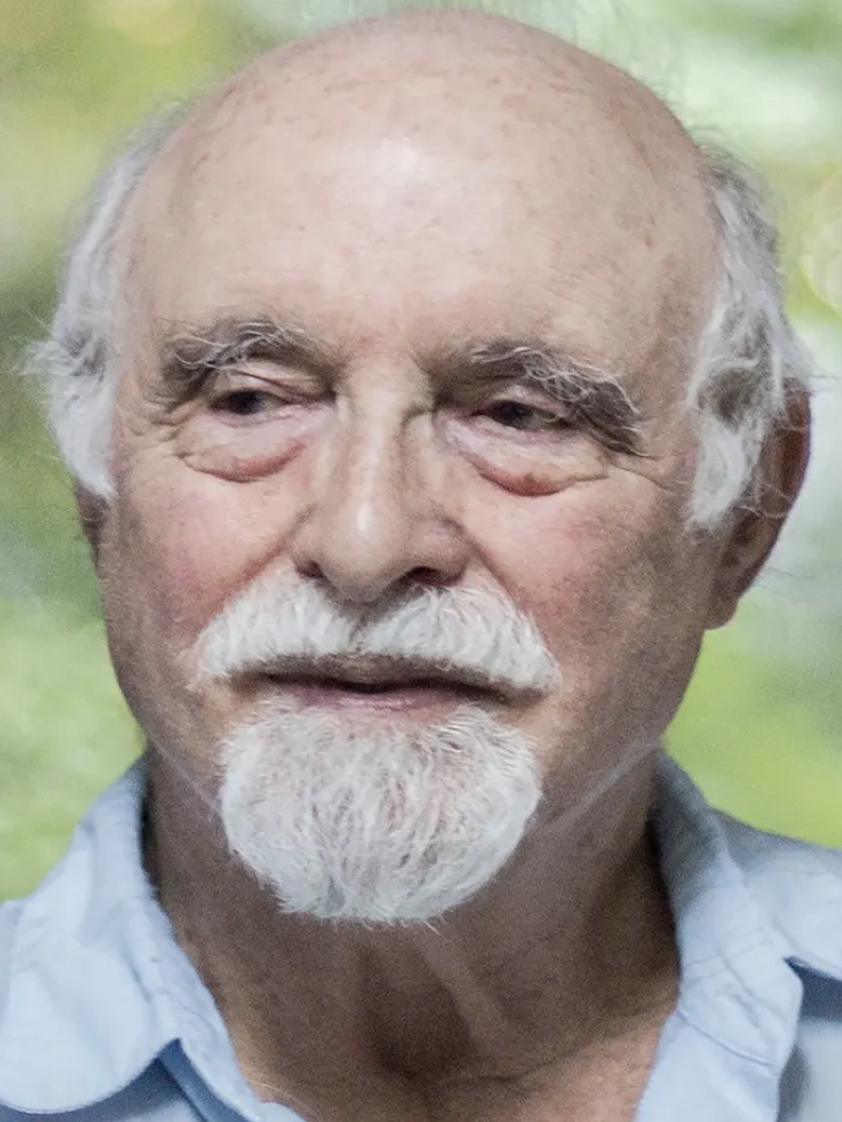
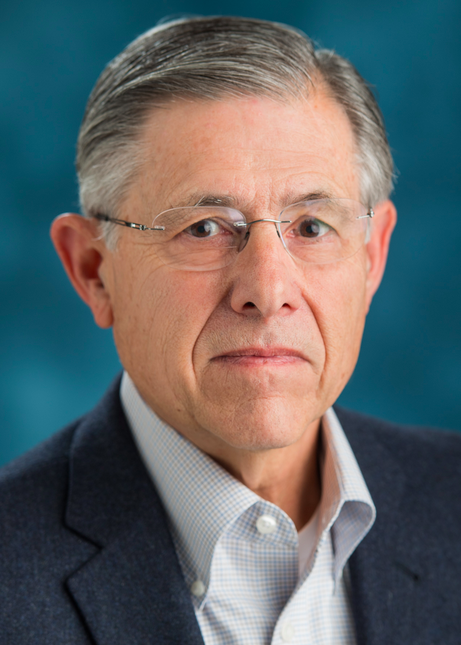
Allan Frey (l) and Nicholas Steneck
Frey, ever independent, persisted and extended his work to the eye’s blood-vitreous humor barrier, a smaller analog of the BBB. At a conference in Washington, DC, in 1981, I heard Frey describe how pulsed microwave radiation could cause leakage there too. This, like Aubineau’s headaches, is a further indication of the general proposition that microwaves could cause membranes to leak.
The U.S. Navy tried to stop Frey from publishing his work on the eye-blood barrier. (This too is in Steneck’s book.) Frey’s paper appeared in 1984 in the Journal of Bioelectricity, which had been founded by Andrew Marino a few years earlier, to serve as an alternative to Bioelectromagnetics, then controlled by the Navy.
Frey ended his paper on the eye barrier by pointing out that there may be similar membranes which are susceptible. “Note should also be taken that there are other blood barriers in the body which are of consequence; one of these is the placental barrier and it deserves attention,” he wrote.
Summing up the Frey BBB story, Steneck decries how the scientific community allowed “social, economic and political pressures” to destroy the credibility of scientific research.
_________________________
While preparing this article, I asked Leszczynski, now semi-retired, to sum up what had happened to him and the others during the second wave. “BBB research was closed prematurely,” he replied. “It is, absolutely, abandoned science.”
Salford and Persson would surely agree.
March 18, 2022
This Story Is Now in German and Norwegian…
Diagnose:Funk, a German-Swiss environmental and consumer group, has translated and republished this article in German, with some additional content and commentary. Here’s the link.
It is also available in Norwegian.
A Danish translation is in the works.
May 7, 2022
…and Danish
The Danish translation is available here.
_________________
1. Aubineau gave a copy of his manuscript to Leszczynski, who made it available to Microwave News.
2. James Merritt of Brooks AFB, one of Frey’s antagonists in the late 1970s, was a coauthor of Mason’s failed repeat of the Salford work some 30 years later. Merritt died in 2019.
3. Over the years, others have studied microwave–BBB interactions. Most recently, Bahriye Sirav and Nesrin Seyhan of the Gazi Non-Ionizing Radiation Protection Center in Ankara, Turkey, have also reported effects. See their 2009 and 2011 papers in Electromagnetic Biology and Medicine, as well as one in the Journal of Neuroanatomy in 2016. (The Center is at Gazi University; Seyhan is now retired.) These and other BBB papers, published between 2007 and 2017, are summarized by Henry Lai in a literature review of the RF neurological effects (CRC Press, 2018). A 2015 Chinese study in Brain Research offers support for both microwave-induced BBB leakage and Leszczynski's mechanistic findings.
4. N. Steneck, The Microwave Debate, MIT Press, 1984, Chapter 7, pp.169-176.

